New Donation: Commodore VC-1541 to Repair + Klain Tape + Some IC.
Material donated:
- Commodore VC-1541 (need to fix it)
- Microcomputer Data Recorder Klain for Commodore 64/VIC20/PET.
- Some IC.
Thanks Alessio for the donation.
Material donated:
Thanks Alessio for the donation.
About 3 months ago i have repaired my Tatung Einstein with stability problems, after a few minutes the screen was filled with random characters. Below the replacement parts:
On the same day has broken the Tatung TC-01 Monitor, the vertical sync is died without any way of adjustment. Yesterday, instead of celebrating Easter, i have tried to repair the monitor, the faulty component was as follows:
Very happy i have connected the Tatung Einstein to the monitor, i have tried a few games and after 15 minutes the Tatung (computer) decided to die. I spent more hours to understand what could have happened, oh! found it, some ram burned. Below the replacement parts:
What could happen again?
I also did the dump of the eprom (rom), the download below.
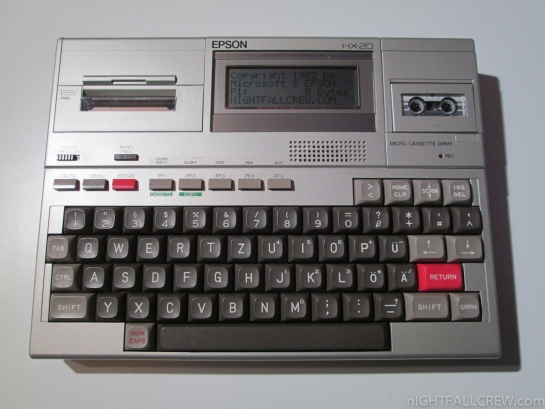
Autopsy:
The latest images of the gallery show how to replace the NiCd accumulators.
from Wikipedia:
The Epson HX-20 (also known as the HC-20) is generally regarded as the first laptop computer, announced in November 1981, although first sold widely in 1983. Hailed by BusinessWeek magazine as the “fourth revolution in personal computing”, it is generally considered both the first notebook and handheld computer.
With about the footprint of an A4 size page, the Epson HX-20 features a full-transit keyboard, rechargeable nickel-cadmium batteries, a built-in 120 × 32-pixel LCD (smaller than that on many mobile phones today) which allowed 4 lines of 20 characters, a calculator-size dot-matrix printer, the EPSON BASIC programming language, two Hitachi 6301 CPUs at 614 kHz which is essentially a souped up Motorola 6801, 16 kB RAM expandable to 32 kB, two RS-232 ports at a maximum of 4800 bits/s for the first 8-pin DIN connector intended for modem or serial printer with the second port capable of 38400 bits/s using a 5-pin DIN connector which was mainly for use with external floppy drive and video display an early concept of docking station, a 300 bit/s acoustic coupler was available, built-in microcassette drive, barcode reader connector.
Uses a proprietary operating system, which consists of the EPSON BASIC interpreter and a system monitor program, and weighs approximately 1.6 kg. Known colours of the machine are silver and cream, while some prototypes were dark grey. The HX-20 was supplied with a grey or brown carry case. An external acoustic coupler, the CX-20, was available for the HX-20, as was an external floppy disk drive, the TF-20, and an external speech synthesis Augmentative Communication Device (ACD), ‘RealVoice’. Another extension was the serially connected 40 x 24 character video. It used a special protocol, EPSP, which was also used by the external floppy disk drive.
The battery life of the HX-20 was approximately 50 hours running BASIC and less using the microcassette, printer or RS-232. The data integrity could be preserved in the 4.0 – 6.0 V range. The power supply was rated for 8 W. Operating and charging it would tolerate 5 – 35 °C. Data integrity could be preserved at -5 – 40 °C. The HX-20 could be stored between -20 – 60 °C. The later, more popular TRS-80 Model 100 line, designed by Kyocera, owed much to the design of the HX-20.
Loading game bomber:
I had several problems with the repair of the Hewlett-Packard HP-85.
The first problem was the way to reconstruct the pinch roller using a latex tube, this is a very bad choice, then i have used a 10mm heat shrink, this choice instead is very good.
The second problem was the rubber parts of the pinch roller are literally dissolved and the rubber is went to cover the optical diode and part of the pcb and of course nothing has worked and the tape drive was always in stalled state.
After cleaning, the drive started to work perfectly. The last problem are the magnetic tapes 3M DC-1000 instead of HP DC-100, for the correct operation you must perform a modification by adding a resistor of 2kohm in parallel to the already present on the pcb. After this mod you need to format the tape with the “erasetape” command.
I must also thank John of the site vintagecomputers.freeserve.co.uk for the support.
Download:
source: voidware.com/calcs/hp85rep hp9845.net vintagecomputers.freeserve.co.uk
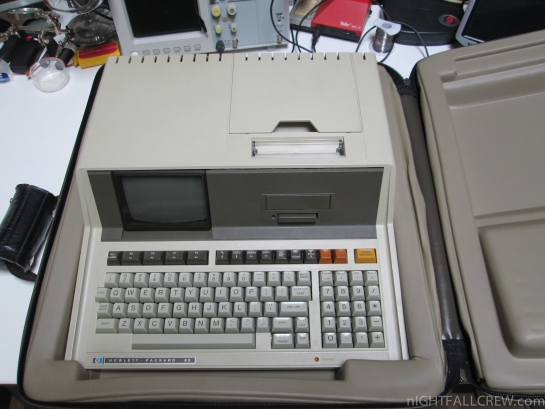
Autopsy:
from Wikipedia:
The Hewlett-Packard series 80 of small scientific desktop computers was introduced in 1980, beginning with the popular HP-85 targeted at engineering and control applications. They provided the capability of the HP 9800 series desktop computers in a smaller package including storage and printer, at half the price. Ultimately, the market for desktop computing would go to IBM PC compatible personal computers (the IBM PC was announced shortly after the 80 series).
 The first model of the Series 80 was the HP-85, introduced in January 1980. In a typewriter-style desktop case, it contained the CPU and keyboard, 16 kB dynamic RAM, a 5-inch CRT screen (16 lines of 32 characters, or 256×192 pixels), a tape drive for DC-100 cartridges (210 kB capacity, 650 B/s transfer) and a thermal printer. Both the screen and printer display graphics in addition to text, and the printer can copy anything shown on the screen. The chassis includes four module slots in the back for expansion which can hold memory modules, ROM extensions, or interfaces such as RS-232 and GPIB.
The first model of the Series 80 was the HP-85, introduced in January 1980. In a typewriter-style desktop case, it contained the CPU and keyboard, 16 kB dynamic RAM, a 5-inch CRT screen (16 lines of 32 characters, or 256×192 pixels), a tape drive for DC-100 cartridges (210 kB capacity, 650 B/s transfer) and a thermal printer. Both the screen and printer display graphics in addition to text, and the printer can copy anything shown on the screen. The chassis includes four module slots in the back for expansion which can hold memory modules, ROM extensions, or interfaces such as RS-232 and GPIB.
All components were designed at the Hewlett-Packard Personal Computer Division in Corvallis, Oregon, including the processor and core chipset. Later models offered variations such as different or external displays, built-in interfaces or a rack-mountable enclosure.
The machines were built around an HP-proprietary CPU code-named “Capricorn” running at 625 kHz (0.6 MHz, sic) and had a BASIC interpreter in ROM (32 kB). Programs could be stored on DC-100 cartridge tapes or on external disk/tape units.
Despite the comparatively low processor clock frequency, the machines were quite advanced compared to other desktop computers of the time, in particular regarding software features relevant to technical and scientific use. The standard number representation was a floating point format with a 12-digit (decimal) mantissa and exponents up to ±499. The interpreter supported a full set of scientific functions (trigonometric functions, logarithm etc.) at this accuracy. The language supported two-dimensional arrays, and a ROM extension made high-level functions such as matrix multiplication and inversion available.
For the larger HP-86 and HP-87 series, HP also offered a plug-in CP/M processor card with a separate Zilog Z-80 processor.
Video:
source: wikipedia
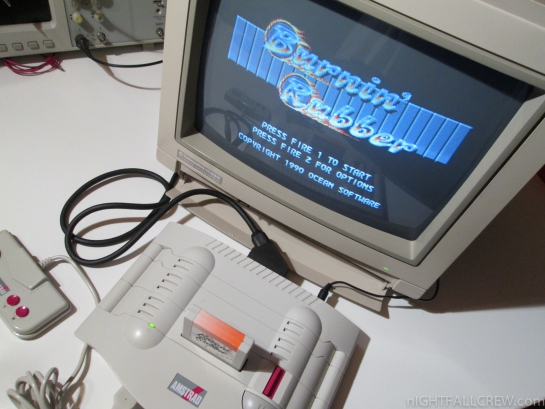
Autopsy:
from Wikipedia:
The GX4000 was Amstrad’s short-lived attempt to enter the games console market. The console was released in Europe in 1990 and was an upgraded design based on the then still-popular CPC technology. The GX4000 shared hardware architecture with Amstrad’s CPC Plus computer line, which were released concurrently, this allowed the system to be compatible with the majority of CPC Plus software.
The GX4000 was both Amstrad’s first and only attempt at entering the console market. Although offering enhanced graphics capabilities, it failed to gain popularity in the market, and was quickly discontinued, selling 15,000 units in total.
James Harding of The Times said that the console was “promptly outgunned by the 16-bit Sega Mega Drive and Super Nintendo – it failed the cardinal test of entrepreneurship: stamina.”
After months of speculation, the GX4000 was officially announced along with the 464 plus, and 6128 plus computers at the CNIT Centre in Paris in August 1990. The system was launched a month later in four countries, Britain, France, Spain, and Italy, priced at £99.99 in Britain, and 990f in France, software was priced at £25 for most titles. The racing game Burnin’ Rubber, a power pack, and two controllers were bundled with the machine.
Initial reviews of the console were favourable, with CVG calling it a “neat looking and technically impressive console that has an awful lot of potential at the very low price of £99″, but while impressed by the graphical capabilities, they criticised the audio and controllers. ACE magazine came to a similar conclusion, stating that the system “puts the other 8-bit offerings to shame bar the PC-Engine”.
A marketing budget of £20 million was set aside for Europe, with the advertising focused on selling the GX4000 as a home alternative to playing arcade games, the tagline for the machine was “Bring the whole arcade into your home!”
source: wikipedia
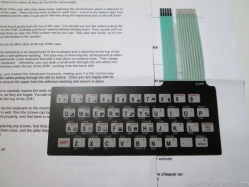
Replacement:
Simple steps to replace the keyboard Membrane of the Sinclair ZX81. The removal of the old keyboard is not illustrated but it is a very easy job.
source: rwapsoftware.co.uk
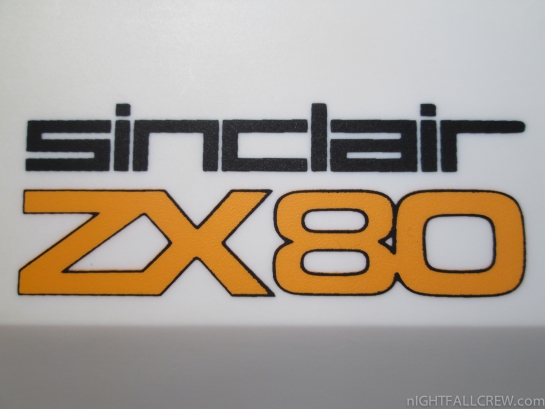
Autopsy:
from Wikipedia:
The Sinclair ZX80 is a home computer brought to market in 1980 by Science of Cambridge Ltd. (later to be better known as Sinclair Research). It is notable for being the first computer (unless one counts the MK14) available in the United Kingdom for less than a hundred pounds (£99.95). It was available in kit form, where purchasers had to assemble and solder it together and as a ready-built version at a slightly higher cost. The ZX80 was very popular straight away, and for some time there was a waiting list of several months for either version of the machine.
Internally, the machine was designed by Jim Westwood around a Z80 central processing unit with a clock speed of 3.25 MHz, and was equipped with 1 kB of static RAM and 4 kB of read-only memory (ROM). The ZX80 was designed around readily available TTL chips; the only proprietary technology was the firmware. While the successor ZX81 used a semi-custom chip (a ULA or Uncommitted Logic Array), this merely combined the functions of the earlier hardware onto a single chip — the hardware and system programs (except the BASIC versions) were very similar, with the only significant difference being the NMI-generator necessary for slow mode in the ZX81. (See ZX81 for technical details.) Both computers can be made by hobbyists using commercially available discrete logic chips or FPGAs.
The ROM contained the Sinclair BASIC programming language, editor, and operating system. BASIC commands were not entered by typing them out but were instead selected somewhat similarly to a scientific calculator – each key had a few different functions selected by both context and modes as well as with the shift key.
The machine was mounted in a tiny white plastic case, with a one-piece blue membrane keyboard on the front; it owed its distinctive appearance to industrial designer Rick Dickinson. There were problems with durability, reliability and overheating (despite appearances, the black stripes visible on the top rear of the case are merely cosmetic, and are not ventilation slots).
source: wikipedia
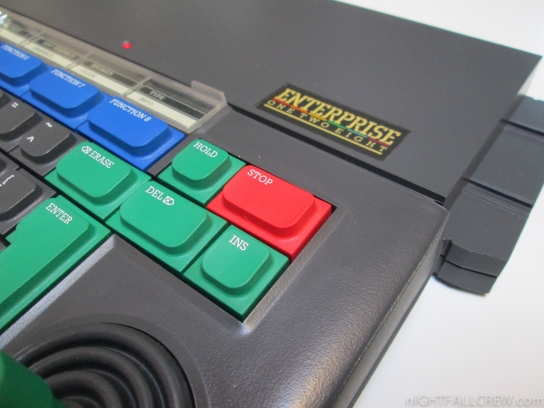
Autopsy:
from Wikipedia:
The Enterprise is a Zilog Z80-based home computer first produced in 1985. It was developed by British company Intelligent Software and marketed by Enterprise Computers. Its two variants are the Enterprise 64, with 64 kilobytes (kB) of Random Access Memory (RAM), and the Enterprise 128, with 128 kB of RAM.
The Enterprise has a 4 megahertz (MHz) Z80 Central processing unit (CPU), 64 kB or 128 kB of RAM, and 32 kB of internal read-only memory (ROM) that contains the EXOS operating system and a screen editor / word processor. The BASIC programming language was supplied on a 16 kB ROM module.
Two application-specific integrated circuit (ASIC) chips take some of the workload off of the central processor. They are named “Nick” and “Dave” after their designers, Nick Toop, who had previously worked on the Acorn Atom, and Dave Woodfield. “Nick” manages graphics, while “Dave” handles sound and memory paging (bank switching).
A bank switching scheme allows the memory to be expanded to a maximum of 4 megabytes (MB). The highest 2 address lines from the Z80 are used to select one of the four 8-bit Page Registers in Dave chip. The output from the selected register is used as the highest 8 bits of the 22-bit address bus, while the lowest 14 bits come directly from the Z80 address bus. Effectively, the 64 kB address space of the Z80 processor is divided into four 16k sections. Any 16k page from the 4 MB address space can be mapped to any of these sections. The lowest two pages (pages 0 and 1) of the 4 MB address space contain system ROM.
The next four pages (2 to 5) are reserved for a ROM cartridge (max 64 kB). The top four pages (pages 252 to 255, totaling 64 kB) are used as video RAM, but can be used for storage of program code and data as well. On the 128k model, the additional 64 kB of ram is mapped on pages 248 to 251. The remaining memory space can be used by external devices and memory modules connected to the expansion bus.
Loading a demo from Tape:
Detailed photo:
I have used the CIF Power Clean and Sponge dishes, with the porous Bakelite (this keyboard) you can also use the rough side of the sponge without any problems. Don’t use the rough side with the plastic.
I have to thank Andrea for giving me this keyboard. The keyboard has replaced the wrong one of my 8296-D.
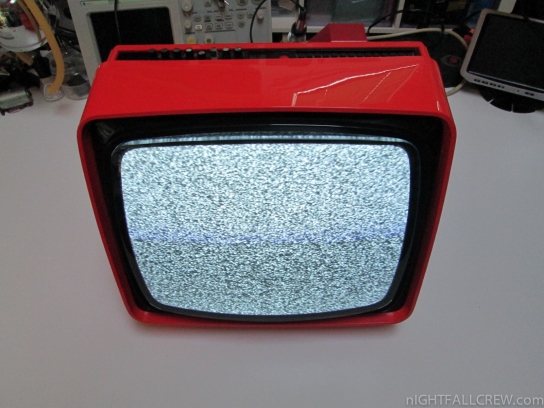
Autopsy:
The Crezar CRT is a portable B/W television with 12 Inches screen format.
The quality of the picture are good even with a non excellent black level stabilization feedback, however was very reliable and almost faultless. Crezar was a little Italian manufacturer of cheap television sets in the 70′s. Crezar was a combination of “Crespi e Zaretti” from Milano.
Video:
TI-99/4A MBX Expansion System Repaired.
The interface MBX Expansion System was dead and the power voltage was in short-circuited. The failure was caused by the filter between the power supply and the 7805.
Video:

Autopsy:
Super Riteman C+ is a Printer for Commodore 64/128 donated by Damiano Colombari (Manosoft). Thanks Damiano.

Autopsy:
from Wikipedia:
ZX Microdrive
The ZX Microdrive was a magnetic tape data storage system launched in July 1983 by Sinclair Research for its ZX Spectrum home computer. The Microdrive technology was later also used in the Sinclair QL and ICL One Per Desk personal computers.
Microdrives used tiny (44 × 34 × 8 mm including protective cover) cartridges containing a 5-metre (200-inch) endless loop of magnetic tape, 1.9 mm wide, driven at 76 cm/second (30 in/second); thus performing a complete circuit in approximately 8 seconds. The cartridges held a minimum of 85 kB when formatted on a ZX Microdrive (exact capacity depended on the number of “bad” sectors found and the precise speed of the Microdrive motor when formatting). The data retrieval rate was 15 kB/s, i.e., 120 kbit/s. It was possible to “expand” the capacity of a fresh microdrive cartridge by formatting it several times. This caused the tape to stretch slightly, increasing the length of the tape loop so that more sectors can be marked out on it. This procedure was widely documented in the Sinclair community magazines of the 1980s.
ZX Interface 1
A peripheral from Sinclair Research for its ZX Spectrum home computer, the ZX Interface 1 was launched in 1983. Originally intended as a local area network interface for use in school classrooms, it was revised before launch to also act as the controller for up to eight ZX Microdrive high-speed tape-loop cartridge drives. It also included a DE-9 RS-232 interface capable of operating at up to 19.2 kbit/s — a rare instance of Sinclair using an industry-standard connector. At hardware level it was mainly a voltage adapter, the serial protocol being implemented in software by bit-banging. This led to problems when receiving data, but not when transmitting.
A wedge-shaped device fitting underneath the ZX Spectrum, ZX Interface 1 contained 8 kB of ROM comprising the control software for the Microdrives, RS-232 port and network interface. This extended the error handler in the Sinclair BASIC to allow extra keywords to be used. As this became an official standard, other developers quickly used this mechanism to create language extensions to Sinclair BASIC.
Download: ZX Microdrive and Interface 1 Manual (PDF) (1120)
source: wikipedia
Recent Comments